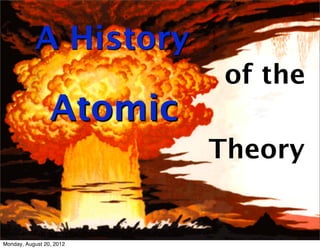
History of Atomic Theory
- 1. A History of the Atomic Theory Monday, August 20, 2012
- 2. In 500 BC Ancient Greece • Democritus philosophized that everything in nature is ultimately made of only one substance. He gave it the name “Atomos”. That means something that cannot be divided. So, if you divide matter down to its smallest thing, then you get something really small and hard to break. He was almost right about it, when considering that most people imagine infinite types of atoms – we now agree on only 90 naturally occurring elements. Monday, August 20, 2012
- 3. 1802 William Wollaston • Wanted a better system for classifying gunpowder to be used during the Napoleonic Wars. He Invented a method of burning the powder and letting the light of the burning material pass through a prism. This rainbow of color would shine against a backdrop, and small pieces of spectrum would be missing. This method of identifying elements by their absorption, and equally common, emission spectra are, both even today, the most preferred techniques. Monday, August 20, 2012
- 4. Early Alchemists Tried to make elements turn in to Gold. They discovered that the best place to find pure elements was close to volcanoes, or geologically active areas. By 1830, 55 elements had been discovered, most of which were metals. Monday, August 20, 2012
- 5. Niels Bohr Uses Wollaston’s element classification with spectral lines to create the Bohr model of the atom. He called the different “pieces” of missing colors in the rainbow – Quanta. He theorized that these lines were caused by electrons orbiting the atoms absorbing discrete packets of energy. Since these always occurred at exact spots in the spectrum, it meant that the electrons must always “live” at exact distances or energies away from the nucleus. This parceling of energy rather than mixing randomly into the entire spectrum of possibility is the basis for quantum theory. Monday, August 20, 2012
- 6. Monday, August 20, 2012
- 7. Modern Atomic Theory – by John Dalton, an English Teacher 1808 • Every element is made of atoms. • All atoms of any element are the same. • Atoms of different elements have different properties (like weight and size). • Atoms of different elements combine to form compounds. • Atoms are not made, destroyed, or changed (in chemical reactions). • The numbers of atoms remain the same (in chemical reactions). Monday, August 20, 2012
- 8. Joseph John Thomson By the end of the 19th century most scientists had agreed on the atomic theory. Thomson reasoned that the blue glow at the cathode end of a tube of gas energized with electricity, is made by small negative pieces of atoms that have almost no mass – “Electrons” Monday, August 20, 2012
- 9. Ernest Rutherford • In 1911 Rutherford performs an experiment where gold film, almost 1 atom thick, is bombarded with alpha particles. He finds that the particles mostly go straight through the film without bouncing off, but they bounce back about 1 out of 10,000 times. Sometimes they come straight back. He reasoned the electrons weren't massive enough to cause a large straight deflection like that, so they must be positively charged to give the deflection extra energy, and the nucleus must be 1/10,000th the size of the whole atom, since it happened 1/10,000 times. Monday, August 20, 2012
- 10. Double-Click to the right to watch movie on Rutherford’s Gold Foil Experiment Monday, August 20, 2012
- 11. If the nucleus of an atom were a pencil eraser placed in the middle of the field, then the electrons would be orbiting the nucleus about the distance of the furthest row of bleachers in a stadium. Monday, August 20, 2012
- 12. • Atoms – smallest piece of matter that can be derived chemically. • Nucleus – the center of the atom. Consists of protons (+ charge), and neutrons (neutral charge). • Electrons – almost weightless, surround the nucleus (- charge) • Molecules – smallest piece of matter that exists in nature (physically) • Element – All of the same kind of atoms • Compound – Different elements put together to make a molecule. (chemically different than its elements) • Mixture – Components mixed and can be separated physically. Monday, August 20, 2012